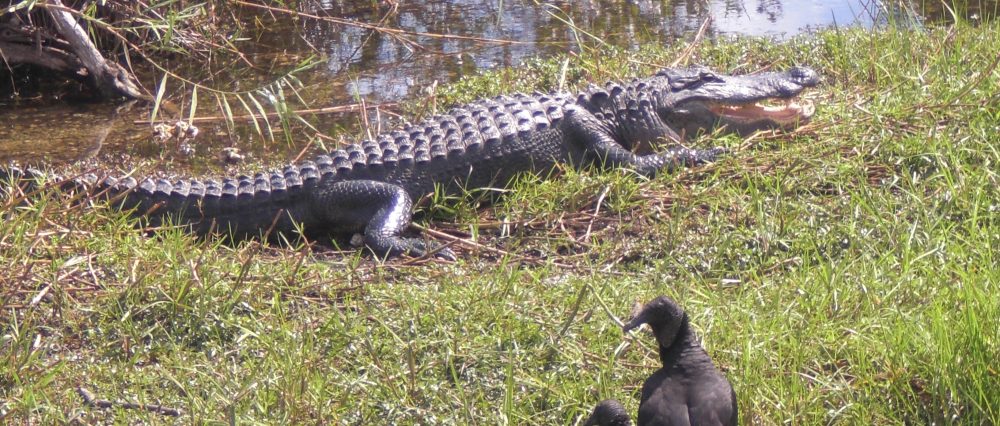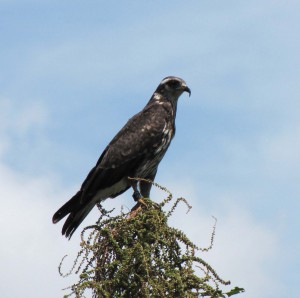
Paul Gray, science coordinator for Audubon of Florida, examines the health of Lake Okeechobee and its marsh grasses — Photo by Purbita Saha
Okeechobee expert helps humans and birds find common ground
By Purbita Saha
Every piece of Florida has its token species. In the southwest, Big Cypress National Preserve has the panther. Everglades National Park, unfortunately, has the Burmese python. To the north, Lake Okeechobee has the scarce and dappled snail kite.
The notion of a token species is both advantageous and unfavorable for conservationists, said Paul Gray, the Lake Okeechobee science coordinator for Audubon of Florida. Since there are numerous species that inhabit the Everglades, it can be beneficial to single out an organism and use it to define the struggles of the ecosystem. On the other hand, concentrating on one plant or animal encourages people to look for over-simplified solutions.
According to Gray, who has spent much of his career on Lake Okeechobee, the Everglades snail kite defies simple solutions. Gray’s success or failure with the now-endangered species shows how difficult it is to repair an intricate and complicated system.
During the past decade, the snail kite has gone from being abundant to rare. In 1998, the lake housed 3,400 individuals. But by 2011, the population was down to just 700. And the baffling thing is, 2011 was actually a good year for the birds.
According to Gray, the kites were able to raise 200 chicks last summer. Yet this population boom was not because of effective management by humans. It was due to an increase in exotic apple snails, which are out-reproducing and out-eating their native counterparts.
The snail kite is a bird of prey, a raptor, that is unique to South Florida, South America and the Caribbean. Its wingspan averages to 43 inches, making it smaller than a hawk or an osprey, but larger than a falcon. Adult males are dark gray, while females and juveniles are brown with flecks of white.
The kite’s diet consists chiefly of apple snails. In fact, the dependency is so strong that the bird has evolved to have a slender, contoured beak that allows it to slip between the snails’ shells and pry them apart. Because of this specialization, the Okeechobee kites rely heavily on the lake. It provides them with ample foraging sites and nesting spots, as long as the water levels remain balanced throughout the opposing seasons.
Exotic snails are double the size of native snails; their girth is comparable to that of a golf ball. Gray said that multiple predators, including alligators and bass, may be keeping the species in check. But the full extent of the snails’ impact is still unknown. “Basically, we’re stumped,” said Gray.

The newer exotic version of the apple snail (left) engulfs the native species with its size and thickness — Photo by Paul Gray
The invasive snails also have a tougher exterior than the natives, which makes it more difficult for the kites to bore into them. To compensate, the raptors have been selecting small snails that are easy to break apart. They have modified their diets so that they can cohabitate with their new prey items. Still, Gray said that he does not want to pin the future of the kites on these exotics, even though the two groups have lived alongside each other for the past seven years.
The snail kite is essential to Okeechobee in that it indicates how healthy the lake is. “If kites aren’t doing fine, the wetlands aren’t functioning right,” said Gray.
Gray has made it his mission to bring the kite populations back to their previous stature. While originally from Missouri, he has spent the past 24 years on Lake Okeechobee. He is the only scientist from Audubon, or any other environmental group, who is fully dedicated to the lake and its watershed. “I’m very much a lone ranger,” he said.
While working toward his doctorate at the University of Florida, Gray studied the mottled duck, a species that is endemic to the Okeechobee area. After finishing his dissertation he joined the short-staffed Florida Game and Fresh Water Fish Commission. He left the job three years later because he felt it focused too much on hunting and recreation, rather than conservation.
Gray was then hired by Audubon of Florida to manage the Kissimmee Prairie Sanctuary and collaborate with the Nature Conservancy in buying 45,000 acres of grassland from private owners. This, he said, was a rewarding experience, for he was able to restore the hydrology of the wetlands and foster diversity in the system.
“My job is to get humans out of the way,” said Gray. His daily tasks include identifying sources for Okeechobee’s ecological problems, finding out why they exist and pitching alternatives to those most involved in the life of the lake. He does not act as an obstructionist; he acts as a mechanic. But now and then, Gray becomes frustrated by the limitations of society. He said that people fall into a repetitive process of mismanaging resources, mostly because they tend to be short-sighted. “We think we’re smart but we’re dumb as individuals and as a population,” said Gray.
Audubon is flexible when dealing with policymakers and big businesses. This has caused the organization to be labeled as a non-profit sell-out. But despite the name calling, Gray believes in cooperating with other environmental teams to create a consensus and a message. He said that in the past, umbrella groups like the Everglades Coalition have succeeded in getting the $13 billion Everglades restoration plan to also focus on Lake Okeechobee. He hopes that these advocates will once again put forth a strident effort to rescue the snail kite from its perilous situation.
There are other birds on Okeechobee, besides kites, which Gray aspires to salvage. He is currently working on an Audubon project that involves the grasshopper sparrow. The species is threatened because it has lost 90 percent of its prairie home. In one part of the swamp, the sparrow population has dipped to just 10 individuals. If climate change causes sea levels to rise as far north as the lake, as long-term projections suggest, marsh birds like the grasshopper sparrow and the Cape Sable seaside sparrow may not be able to follow the retreating fresh water. Hence, the future of these native species depends on their ability to be elastic in harrowing situations, said Gray.
Migratory birds from South America and the Arctic also take shelter on Okeechobee every year. They need to refuel at the lake before continuing on their long and arduous journeys. But with receding habitats and diminishing fish and invertebrate populations, these nomadic birds are being seen less often within the vicinity of South Florida.
At age 55, Gray’s endurance is still strong. He says he intends to work on the lake for another 10 years, before branching out and applying his influence to state-wide issues.
While successes do come, they are hard to see on a day-to-day basis. In fact, Gray said that most days he does not feel like he is making a difference. “It’s a marathon, not a sprint,” he said.
Progress occurs over multiple generations. Just as Gray looks to the triumph of the Kissimmee River project for inspiration, he foresees that future conservationists will look to Okeechobee and its kites to light their own ambitions.

